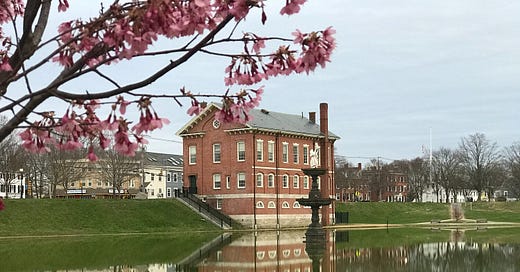In 1994 architect and critic Jonathan Hale wrote a brilliant little book titled The Old Way of Seeing. In it, he laments the loss of life and play in modern American architecture.
Hale points to 1830 as the turning point.
Hale says prior to the 1830s architecture was altogether focused on something different. There was a magic to it—and intuitive beauty that made a person feel at home in their town.
“Architecture,” he says, “is the play of patterns derived from nature and ourselves.” He says that design is play, and “The disharmony we see around us is the exception.”
Architects now build lifeless structures that lack an identity and convey a kind of chaos rather than harmony. We feel this intrinsically, he says, though we may be unable to explain it fully. We sense it when we walk our neighbourhoods that tend to look monolithic, struggling under the burden of sameness and laden with symbols of times past in an attempt to convey something.
He attributes this loss of play and life in architecture to a lack of sight; a loss of the old way of seeing. Hale tracks this loss of sight to the 1820’s when architecture lost its charm and delight. Buildings, says Hale, began to strike poses using symbols, like pillars, to communicate some kind of code, like heroic democracy or “greatness of vision.” Architecture turned from “expressions of the human spirit to structures laden with symbols.” A loss of magic and life.
Pattern ruled architecture before the 1820s. Patterns are ends in themselves and communicate directly to the viewer. After the 1830s everyday architecture attempted to either communicate through symbols instead of patterns, or not to communicate at all.
The pressure for the modern designer of the 19th century, yea, even the artist, was to be always new. And by new Hale means strangeness. Not only is this is a burden for the designer but it also moves beauty further out of reach of the everyday person. Beauty becomes the province of specialists.
“Eh, but Tim,” you say, “I’m no architect. The only thing I design is avocado toast or perhaps my evening salad. What do Hale’s observations of modern architecture have to do with me?”
“Ah yes,” I reply. “Yes, architecture does sound like a distant discipline. But I had to remind myself that the buildings that surround us contribute to our immediate environment. Consciously or not, the vision of the Waxhaw Mainstreet affects my mood, my visual delight or visual disgust. And that which comes into my optics does indeed affect me on a deeper level.”
There is a sacredness to the places we build. You and I were created to create. We are, by design, builders and makers, and even if that is not our profession, we are wired to interpret the places we inhabit.
A place of chaos breeds tension. A place of pattern and play breeds, well, magic.
Whether it is a flower bed design, a perfectly patterned deck, or a playful chapel inviting us to worship, the places we inhabit connect us to something beyond the brick and mortar. Their pattern and play give us the joy of something familiar, the delight of home, and remind us that flourishing—that life itself—can and should be found in the places we gather.
Stay stoked my friends.












Share this post